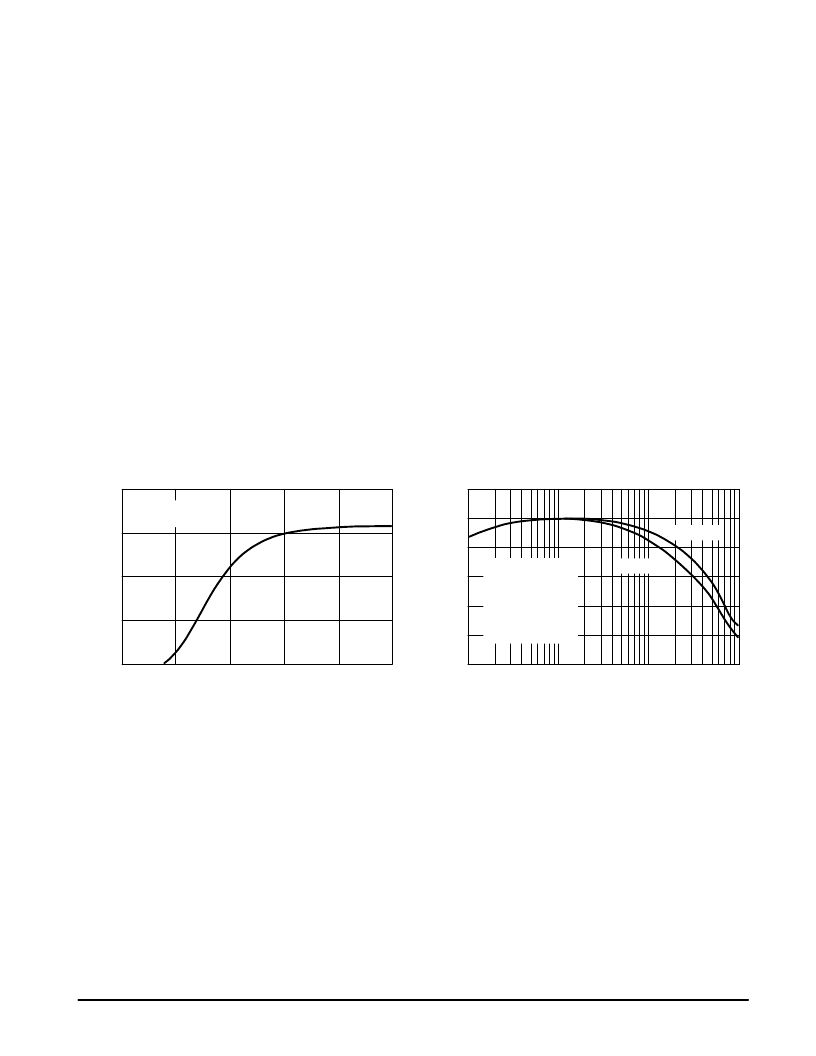- 您現(xiàn)在的位置:買賣IC網(wǎng) > PDF目錄371008 > MC13150 (Motorola, Inc.) NARROWBAND FM COILLESS DETECTOR IF SUBSYSTEM FOR CELLULAR AND ANALOG APPLICATIONS PDF資料下載
參數(shù)資料
| 型號: | MC13150 |
| 廠商: | Motorola, Inc. |
| 英文描述: | NARROWBAND FM COILLESS DETECTOR IF SUBSYSTEM FOR CELLULAR AND ANALOG APPLICATIONS |
| 中文描述: | COILLESS探測器窄帶調(diào)頻中頻移動電話和模擬應用子系統(tǒng) |
| 文件頁數(shù): | 7/20頁 |
| 文件大小: | 514K |
| 代理商: | MC13150 |

MC13150
7
MOTOROLA ANALOG IC DEVICE DATA
Coilless Detector
The quadrature detector is similar to a PLL. There is an
internal oscillator running at the IF frequency and two
detector outputs. One is used to deliver the audio signal and
the other one is filtered and used to tune the oscillator.
The oscillator frequency is set by an external resistor at
the Fadj pin. Figure 9 shows the control current required for a
particular frequency; Figure 10 shows the pin voltage at that
current. From this the value of RF is chosen. For example,
455 kHz would require a current of around 50
μ
A. The pin
voltage (Pin 16 in the 32 pin QFP package) is around 655mV
giving a resistor of 13.1 k
. Choosing 12 k
as the nearest
standard value gives a current of approximately 55
μ
A. The
5.0
μ
A difference can be taken up by the tuning resistor, RT.
The best nominal frequency for the AFTout pin (Pin 17)
would be half supply. A supply voltage of 3.0 Vdc suggests a
resistor value of (1.5 – 0.655)V/5.0
μ
A = 169 k
. Choosing
150 k
would give a tuning current of 3/150 k = 20
μ
A. From
Figure 9 this would give a tuning range of roughly 10 kHz/
μ
A
or
±
100 kHz which should be adequate.
The bandwidth can be adjusted with the help of Figure 11.
For example, 1.0
μ
A would give a bandwidth of
±
13 kHz. The
voltage across the bandwidth resistor, RB from Figure 12 is
VCC – 2.44 Vdc = 0.56 Vdc for VCC = 3.0 Vdc, so
RB = 0.56V/1.0
μ
A = 560 k
. Actually the locking range will
be
±
13 kHz while the audio bandwidth will be approximately
±
8.4 kHz due to an internal filter capacitor. This is verified in
Figure 13. For some applications it may be desirable that the
audio bandwidth is increased; this is done by reducing RB.
Reducing RB widens the detector bandwidth and improves
the distortion at high input levels at the expense of 12 dB
SINAD sensitivity. The low frequency 3.0dB point is set by the
tuning circuit such that the product
RTCT = 0.68/f3dB.
So, for example, 150 k and 1.0
μ
F give a 3.0 dB point of
4.5 Hz. The recovered audio is set by RL to give roughly
50mV per kHz deviation per 100 k of resistance. The dc level
can be shifted by RS from the nominal 0.68 V by the following
equation:
Detector DC Output = ((RL + RS)/RS) 0.68 Vdc
Thus, RS = RL sets the output at 2 x 0.68 = 1.36 V;
RL = 2RS sets the output at 3 x 0.68 = 2.0 V.
Figure 12. BWadj Current
versus BWadj Voltage
BWadj VOLTAGE (Vdc)
Figure 13. Demodulator Output
versus Frequency
2.3
2.5
2.7
f, FREQUENCY (kHz)
0.1
1.0
10
100
D
10–3
10–4
10–5
10–6
10–7
VCC = 3.0 Vdc
TA = 25
°
C
10
0
–10
–20
–30
–50
–40
VCC = 3.0 Vdc
TA = 25
°
C
fRF = 50 MHz
fLO = 50.455 MHz
LO Level = –10 dBm
No IF Bandpass Filters
fdev =
±
4.0 kHz
RB = 560 k
RB = 1.0 M
B
相關(guān)PDF資料 |
PDF描述 |
|---|---|
| MC13150FTB | NARROWBAND FM COILLESS DETECTOR IF SUBSYSTEM FOR CELLULAR AND ANALOG APPLICATIONS |
| MC13156DW | WIDEBAND FM IF SYSTEM FOR DIGITAL AND ANALOG APPLICATIONS |
| MC13156FB | WIDEBAND FM IF SYSTEM FOR DIGITAL AND ANALOG APPLICATIONS |
| MC13158FTB | WIDEBAND FM IF SUBSYSTEM FOR DECT AND DIGITAL APPLICATIONS |
| MC1315P | CBS SQ LOGIC DECODER SYSTEM |
相關(guān)代理商/技術(shù)參數(shù) |
參數(shù)描述 |
|---|---|
| MC13150FTA | 制造商:MOTOROLA 制造商全稱:Motorola, Inc 功能描述:NARROWBAND FM COILLESS DETECTOR IF SUBSYSTEM FOR CELLULAR AND ANALOG APPLICATIONS |
| MC13150FTB | 制造商:LANSDALE 制造商全稱:LANSDALE Semiconductor Inc. 功能描述:Narrowband FM Coilless Detector IF Subsystem |
| MC13155 | 制造商:MOTOROLA 制造商全稱:Motorola, Inc 功能描述:WIDEBAND FM IF |
| MC13155D | 制造商:LANSDALE 制造商全稱:LANSDALE Semiconductor Inc. 功能描述:Wideband FM IF |
| MC13156 | 制造商:MOTOROLA 制造商全稱:Motorola, Inc 功能描述:Wideband FM IF System |
發(fā)布緊急采購,3分鐘左右您將得到回復。